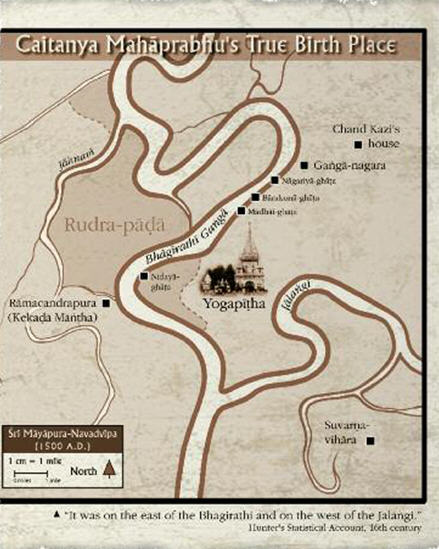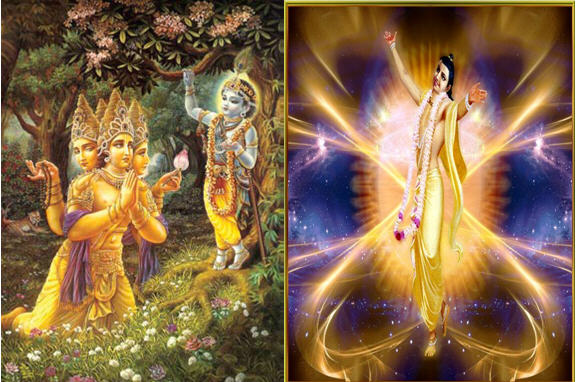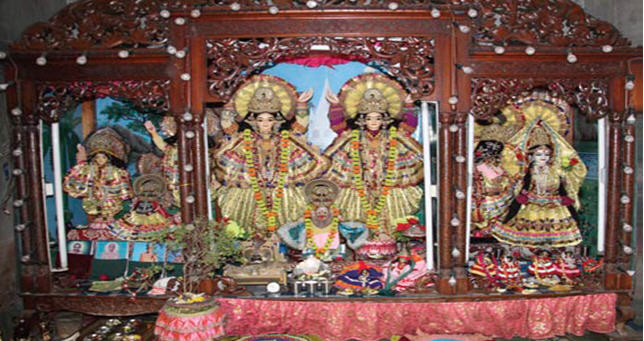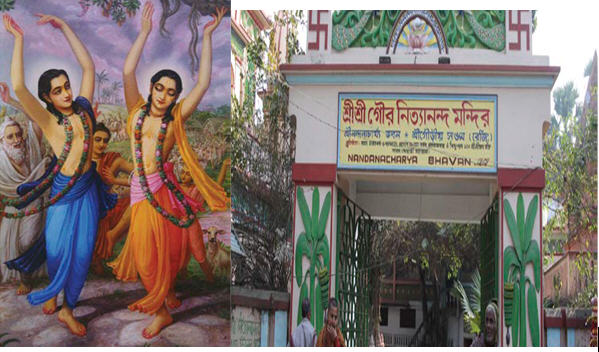
There has been a centuries’ old controversy regarding the location of Old Navadvipa, Sriman Mahaprabhu’s birthplace. The information in this section comes from the book Citre-navadvipa by Sri Saradindu Narayana Raya (published by Sri Caitanya Matha, Mayapura). This information gives conclusive proof that Old Navadvipa was situated on the eastern bank of the Ganga. The English excerpts from the above-mentioned book have been quoted directly.
By studying scriptures such as Urddhamnaya Maha-tantra, Sri Caitanya-caritamrita and Bhakti-ratnakara it is clear that Old Navadvipa was situated on the Ganga’s (Bhagavati-Bhagirathi’s) eastern bank. The Urddhamnaya Maha-tantra states:
vartateha navadvipe nityadhamni mahesvari
bhagirathi tatepurve mayapurantu gokulam
O Mahesvari, Sri Navadvipa-dhama is eternal, and Mayapura, which is situated on the Bhagirathi’s eastern bank, is the same as Gokula.
Sri Caitanya-caritamrita (Adi-lila 1.86) states: “… gaudadese purva-saile karila udaya – … they arose on the eastern horizon in the land of Gauda.” And Adi-lila 13.97 states: “nadiyaudayagiri, purnacandra gaurahari, kripa kari’ ha-ila udaya – thus by His causeless mercy the full moon, Gaurahari, rose in the district of Nadiya, which is compared to Udayagiri, where the sun first becomes visible”.
Sri Navadvipa-parikrama by Srila Narahari Cakravarti states:
sri-suradhunira purva-tire
antardvipadika catushtaya sobhakare
jahnavira pascikulete
koladvipadika panca vikhyata jagate
Antardvipa and three other islands are situated in full splendour on the eastern bank of the Suradhuni (Ganga), and Sri Antardvipa Koladvipa and four other famous islands are on the Jahnavi’s (Ganga’s) western bank. In the 16th century, during the British Empire’s occupation of India, Sir William Hunter produced an authoritative historical and geographical record of India, focusing on many well known places in Bengal. In this record (Hunter’s Statistical Account, pg 142) he described the geographical position of Navadvipa Town.
“It was on the east of the Bhagirathi and on the west of the Jalangi.”
In other words, Navadvipa town was situated on Bhagirathi’s eastern bank and Jalangi’s western bank. From the explanations in the Nadiya Gazetteer one can understand that Navadvipa was the capital of the kings of the Sena dynasty: “Nabadwip is a very ancient city and is reported to have been founded in A.D. 1063 by one of the Sen kings of Bengal. In the Aini Akbari it is noted that in the time of Lakhana Sen, Nadia was the capital of Bengal.” Navadvipa is an ancient city, said to be founded in 1063 by a king of the Sena dynasty. Aini Akbari also mentions that Navadvipa was the capital of Bengal during the reign of Maharaja Sri Lakshmana Sena.
In his statistical account (pg. 142) Sir William Hunter also has mentioned that Maharaja Lakshmana Sena founded Nadiya in A.D. 1063.
The following statement appeared in the Calcutta Review (pg. 398, 1946):
“The earliest that we know of Nadia is that in 1203 it was the Capital of Bengal.”
In other words, our first information about Nadiya Town is that it was the capital of Bengal in 1203. In this way much proof supports the fact that old Nadiya, or old Navadvipa, was the capital of the kings of the Sena dynasty and was situated on the Ganga’s eastern bank.
The Nadiya District Gazetteer provides further evidence: “The nature of Mahammadi Baktier’s conquest (A.D. 1203) appears to have been exaggerated. The expedition to Nadia was only on in-road, a dash for securing booty. The troopers looted the city with the palace and went away. They did not take possession of the part. It seems probable that the hold of Mohammedans upon the part of Bengal in which Nadia district lies was very slight for the two centuries which succeeded the sack of Navadwip by Baktier Khan. It appears, however, that by the middle of the fifteenth century the independent Mahammedan Kings of Bengal had established their authority.”
It seems that the description of the conquest of Navadvipa by Baktiyara Khan (1203) was exaggerated. The sole reason Baktiyara Khan invaded Nadiya was to loot its riches. It was a sudden attack in which the cavalry plundered the royal palace and Navadvipa Town, and then left. They never established any authority over the town, although it is possible that after their attack on Navadvipa, Baktiyara Khan was its authority in name only. If so, this authority lasted for the duration of two centuries.
In the middle of the 15th century, the independent Muslim emperors established their authority over Bengal. Nadiya Gazetteer and Hunter’s Statistical Account (pg. 142) clearly prove that the highland adjacent to present Mayapura is actually the ruins of King Ballala Sena’s palace and that Nadiya Town was his capital. Ballala-dighi (Prithu-kunda) was situated nearby.
Over time, the course of the Ganga’s flow occasionally changed and gradually it washed away the old Navadvipa Town, which was later founded again on the western bank. Old Navadvipa, or Nadiya Town, is now known by various names, such as Brahmana-pukura, Bel-pukura, Sri Mayapura, Ballaladighi and Srinathapura. The present Sridhama Mayapura is where Sri Jagannatha Misra’s house, Srivasa-angana, Advaitabhavana, Murari Gupta-bhavana and other places were situated.
The place known as Kuliya-grama (or Pahada-pura) during Mahaprabhu’s time, is where the present Navadvipa Town and Municipality are situated. Old maps give evidence of this.
Bhakti-ratnakara is an old and authoritative scripture which was composed by the well-known Srila Narahari Cakravarti Thakura. In its description of Navadvipa-dhama parikrama,Bhakti ratnakara gives clear evidence to support that Antardvipa Mayapura, which was situated on the Ganga’s eastern bank, was the old Nadiya, or Navadvipa Town. Even today Chand Kazi’s samadhi, Sridhara-angana and other places are situated on the eastern bank. When Srinivasa Acarya and Sri Narottama Thakura performed parikrama with Isana Thakura, they visited Jagannatha-bhavana and the nearby Barakonaghata, Ganga-nagara and so forth, and without crossing the Ganga, they went to Chand Kazi’s samadhi, Sridhara-angana, Simuliya and other places.In 1684 William Hayes, an agent of the East India Company,wrote in his diary about Richard Temple’s old map, which also shows that Navadvipa Town was situated on Bhagirathi’s eastern bank.
In 1572, Kavi-karnapura wrote his famous play Sri Caitanyacandrodaya. From the geographical description given there it is clear that the old Navadvipa, or Nadiya Town, was situated on the Ganga’s eastern bank and that Kuliya-grama was situated on the western bank.
Sri Vrindavana dasa Thakura compiled Sri Caitanya bhagavata just a few years after the disappearance of Sri Caitanya Mahaprabhu. From the descriptions in this book one can get to know the geographical location of Navadvipa and nearby places. Everyone accepts that the samadhi of Chand Kazi, who was a contemporary of Sri Caitanya Mahaprabhu, is situated in Vamana-pukura (also known as Brahmana-pukura and Brahmana-pushkarini). According to Sri Caitanya bhagavata’s narration of Chand Kazi’s defeat, Sriman Mahaprabhu took a large sankirtana party to Chand Kazi’s residence, but there is no mention that they crossed the Ganga.
From the above-mentioned proofs it is clear that the place indicated by Srila Jagannatha Dasa Babaji Maharaja and Srila Bhaktivinoda Thakura in Sri Mayapura-dhama is the actual place of Sri Caitanya Mahaprabhu’s appearance.
Some people say that Ramacandrapura, or Kekada Mantha, situated on the Ganga’s western bank, is the actual site of Sri Caitanya Mahaprabhu’s appearance and is therefore the ancient Mayapura. This assumption, however, is completely baseless and opposed to the above proofs. Some reasons for this, in brief, are:
(1) If Ramacandrapura were Mahaprabhu’s appearance place and Chand Kazi’s house was on the other side of the Ganga, Sriman Mahaprabhu and His kirtana party would have had to cross the Ganga to go from Ramacandrapura to the Kazi’s house on the day of the Kazi’s defeat. But Sri Caitanya-bhagavata does not mention that Sriman Mahaprabhu crossed the Ganga.
(2) To go from Ramacandrapura to the Kazi’s house in Vamana-pukura via Ganga-nagara, one has to go through Rudra-pada. There is no alternate route. Sriman Mahaprabhu led the sankirtana party through many ghats on the banks of the Ganga. Then, finally arriving at Ganga-nagara, He came to the Kazi’s house. If the sankirtana party had started at Ramacandrapura, the distance travelled would have been 6–8 miles.
(3) In the narration of Srinivasa Acarya’s parikrama, it is mentioned that he went to Simuliya (Simanta dvipa) from Antardvipa. Even today, the Kazi’s house and samadhi are on the path from present Mayapura (Antardvipa) to Simuliya. If we take Ramacandrapura to be Antardvipa Mayapura, however, then to reach Simuliya from there one must surely cross Rudra-pada, or Rudradvipa.
Srinivasa Acarya finally arrived in Rudradvipa after going to Jannagara ( Jahnudvipa), then to Mamagachi (Modadrumdvipa) and Mahatpura (Matapura), etc. If Srinivasa Acarya had begun his Navadvipa-dhama parikrama from Ramacandrapura, how would he have reached Simuliya first, and then Gadigacha (Godrumadvipa) and Majida (Madhyadvipa), and after crossing the Ganga, Kuliya (Koladvipa), Ratudvipa- Ratupura (Ritudvipa), Jannagara (Jahnudvipa), Mamagachi (Modadrumadvipa) and finally Rudra-pada (Rudradvipa)? Consequently, it must be concluded that he started his parikrama from the present Antardvipa Mayapura situated on the Ganga’s eastern bank. This conclusion is in accordance with the description given in Bhakti-ratnakara and with old maps.
(4) It is mentioned in Bhakti-ratnakara that one can see Suvarna-vihara from Antardvipa. Even today one can see Suvarna-vihara from the present Mayapura. But if Ramacandrapura is considered to be Antardvipa it is impossible to see Suvarna-vihara, which is situated about 5–6 miles away.
(5) If Ramacandrapura is the place of Sriman Mahaprabhu’s appearance, and if Ganga-Govinda Singh considered that place to be Sriman Mahaprabhu’s birthplace and built a temple there, why are the deities of Sri Rama-Sita established in this temple? Why didn’t he establish a deity of Sriman Mahaprabhu, and why didn’t he call this place Mayapura? And why is this place known as Ramacandrapura on the old government maps?
(6) It is well-known that there is a huge Sri Rama-Sita festival celebrated with great pomp in Ramacandrapura.
This Ramacandrapura is situated within Modadrumadvipa, Sri Ramacandra and Sitaji’s pastime-place. Hence, this place cannot also be assumed to be Antardvipa Mayapura.
These and other facts give clear proof that Ramacandrapura, or Kekada Mantha, is definitely not Sriman Mahaprabhu’s appearance place. Srila Bhaktivinoda Thakura and Antardvipa Mayapura.
Sri Saccidananda Bhaktivinoda Thakura, Sri Caitanya Mahaprabhu’s eternal intimate associate, is revered as the Seventh Gosvami who again inaugurated the flow of the Bhagirathi of bhakti. He appeared in this world to manifest Mahaprabhu’s holy name (gaura-nama), His innermost desire (gaura-kama) and His holy abode (gauradhama). Like Sri Rupa and Sri Sanatana, he wanted to reside in Vraja and perform bhajana there. On his way to Vraja-mandala he came to a deity of Lord Siva, Mahadeva Sri Tadakesvara, a short distance from Kolkata. That night Sri Mahadeva appeared to him in a dream and requested him to reveal Sri Gauranga Mahaprabhu’s appearance-place. He also told him to remain in Gauda-mandala and perform bhajana. Sri Bhaktivinoda Thakura placed Sri Tadakesvara’s instruction upon his head and returned to Sridhama Navadvipa. There, in Godrumadvipa, he constructed a small hut and began performing bhajana, eager to find Sriman Mahaprabhu’s appearance-place. He wrote in his autobiography:
“I was very anxious to find Sriman Mahaprabhu’s appearance place. I went to Navadvipa (the present Navadvipa Town) and with much endeavour made some investigation, but was unable to find any trace of it. Thus I became very unhappy. Nowadays the people of Navadvipa are only busy filling their bellies.
They know nothing about Sriman Mahaprabhu’s pastime-places, nor do they endeavour to learn about them. One day after twilight, at ten o’clock, Kamala and I, together with one clerk, were standing on the roof of the Rani Dharmasala looking about. It was very dark and the sky was filled with clouds. Then, across the Ganga towards the north I saw an effulgent mansion. I asked Kamala, ‘Did you see something?’ He answered, ‘I became awestruck to see an effulgent mansion on the other side of the Ganga towards the north.’ In the morning I again went to the roof of the Rani Dharmasala and attentively looked towards that place. I was unable to see the effulgent mansion, but I could see a palm tree there. When I inquired from others about that place, they said it was called Ballala-dighi and that one can still see many traces of King Lakshmana Sena’s old fort there. The coming Monday I went to Krishna-nagara and the following Saturday I went straight from there to Ballala-dighi. That night I beheld a wondrous sight. Sriman Mahaprabhu, Sri Nityananda Prabhu, Sri Advaita Acarya, Sri Gadadhara and the other devotees were completely absorbed in chanting and dancing ecstatically. Everyone’s eyes were filled with tears. The tumultuous sound of “Hari Bol!” and the sound of mridangas and kartalas maddened the devotees. After sometime that sight disappeared from my eyes.
“The next day I walked to those places to take darsana of them and asked the elderly locals about them. They told me that this was Sriman Mahaprabhu’s birthplace. I visited all the small villages mentioned in Bhakti-ratnakara as well as those mentioned in Srila Vrindavana dasa Thakura’s Sri Caitanyabhagavata. Thereafter I sat in Krishna-nagara and compiled the book Sri Navadvipa-dhama-mahatmya and sent it to be printed in Kolkata. I told Sri Dvarika Babu, an engineer from Krishna-nagara, about my findings. He could understand everything I said and on the strength of his intelligence he produced a map of Sri Navadvipa-mandala. I then wandered throughout Navadvipa-dhama and wrote the Dhamamahatmya, because at that time I could do nothing else.”
In Godruma, 1893, Srila Bhaktivinoda Thakura performed a great harinama-sankirtana festival under the auspices of Srila Jagannatha dasa Babaji Maharaja. At that time Sri Jagannatha dasa Babaji Maharaja went with many Vaishnavas to take darsana of Sri Mayapura. Overwhelmed by ecstatic sentiments, he himself pointed out Mahaprabhu’s birthplace, the lost Yogapitha-Mayapura. The 144-year-old Babaji Maharaja became overwhelmed with ecstasy and jumped into the air, crying out, “This is the birthplace of Gauracandra, our very life and soul!” Srila Bhaktivinoda Thakura, many famous writers of Bengal, many high-posted government officers, editors of famous magazines and others witnessed the event. Amongst them was Sri Syamalala Gosvami, the great and erudite Vaishnava. Also present were Sri Sasibhushana Gosvami, Sri Radhikanatha Gosvami, Sri Vipina Bihari Gosvami, Sri Raya Vanamali, Sri Raya Bahadura, Sri Sisira Kumara Ghosha, Sri Dvarikanatha Sarakara and Sri Naphara Kumara. Some huts were eventually made here and the temple construction began. Gradually, faithful devotees from the various states of India came here to take darsana, and now, people come from all over the world to this holy place.


